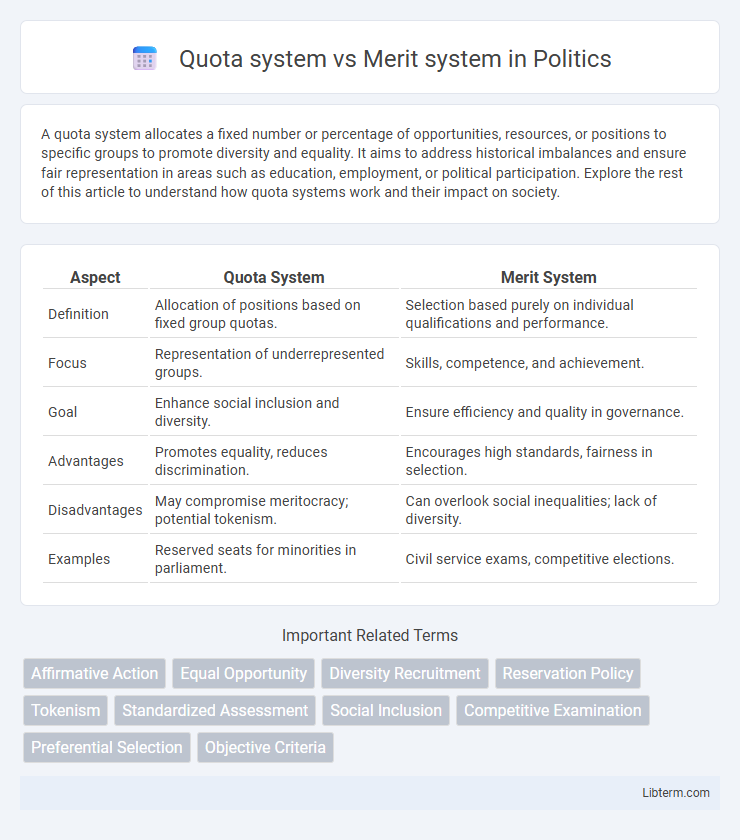A quota system allocates a fixed number or percentage of opportunities, resources, or positions to specific groups to promote diversity and equality. It aims to address historical imbalances and ensure fair representation in areas such as education, employment, or political participation. Explore the rest of this article to understand how quota systems work and their impact on society.
Table of Comparison
| Aspect | Quota System | Merit System |
|---|---|---|
| Definition | Allocation of positions based on fixed group quotas. | Selection based purely on individual qualifications and performance. |
| Focus | Representation of underrepresented groups. | Skills, competence, and achievement. |
| Goal | Enhance social inclusion and diversity. | Ensure efficiency and quality in governance. |
| Advantages | Promotes equality, reduces discrimination. | Encourages high standards, fairness in selection. |
| Disadvantages | May compromise meritocracy; potential tokenism. | Can overlook social inequalities; lack of diversity. |
| Examples | Reserved seats for minorities in parliament. | Civil service exams, competitive elections. |
Understanding Quota System: Definition and Origins
The quota system is a policy designed to allocate a specific number or percentage of opportunities, such as educational seats or job positions, to underrepresented or disadvantaged groups based on factors like race, ethnicity, or socioeconomic background. Originating in the mid-20th century as a response to historical inequalities and social discrimination, the quota system aims to promote diversity and equal representation in sectors where certain groups have been marginalized. This approach contrasts with merit-based systems by prioritizing demographic factors to achieve social equity rather than solely focusing on individual qualifications or performance metrics.
What is Merit System? Concepts and Principles
The Merit System is a human resource management approach that emphasizes hiring and promoting individuals based on their qualifications, skills, and performance rather than factors such as race, gender, or political affiliation. It upholds principles of fairness, competence, and equal opportunity, ensuring that positions are filled by the most capable candidates to enhance organizational efficiency. This system relies on objective evaluations, standardized testing, and transparent criteria to maintain integrity and meritocracy in employment decisions.
Historical Context: Quota vs Merit in Education and Employment
The quota system emerged in the mid-20th century as a mechanism to address historical inequalities and ensure representation of marginalized groups in education and employment, often implemented through affirmative action policies. In contrast, the merit system bases opportunities primarily on individual qualifications, performance, and achievements, emphasizing equal competition without considering social background. Historical shifts in various countries reflect ongoing debates between equity-driven quotas and performance-driven meritocracy in shaping inclusive yet competitive educational and professional landscapes.
Key Advantages of Quota System
The quota system ensures representation for marginalized and underrepresented groups by reserving a specific percentage of positions, promoting social equity and diversity. It facilitates access to education and employment opportunities for disadvantaged communities, helping to bridge historical inequalities. This system fosters inclusivity and reduces disparities by guaranteeing minimum participation from various social segments in institutions and workplaces.
Core Benefits of Merit System
The merit system promotes fairness and efficiency by rewarding individuals based on skills, qualifications, and performance, ensuring the most competent candidates advance in organizations. This system enhances productivity and motivation, as employees see their efforts directly linked to career progression and compensation. It also fosters a culture of meritocracy, which helps attract and retain top talent by emphasizing objective criteria over demographic factors.
Main Criticisms of Quota System
The quota system faces criticism for promoting reverse discrimination and undermining meritocracy by allocating opportunities based on group identity rather than individual qualifications. Critics argue it can perpetuate dependency and stigmatize beneficiaries, reducing incentives for excellence and fostering divisions within society. Many claim the system overlooks individual merit and merit-based achievements, leading to inefficiencies in education and employment sectors.
Major Drawbacks of Merit System
The major drawbacks of the merit system include potential bias in evaluating candidate qualifications, often favoring those with access to better education and resources, which can lead to social inequality. This system may overlook diverse talents and skills that are not easily measurable through standardized criteria, limiting inclusivity. Furthermore, rigid emphasis on merit can increase stress and competition, reducing collaboration and morale among applicants or employees.
Social Impact: Equity, Diversity, and Inclusion
The quota system promotes equity by ensuring representation of marginalized groups, directly addressing historical inequalities and fostering diversity in workplaces and educational institutions. The merit system emphasizes qualifications and performance, which can sometimes overlook systemic barriers faced by underrepresented communities, potentially limiting inclusion. Balancing both approaches can enhance social impact by creating opportunities for diverse talents while maintaining standards of excellence.
Global Case Studies: Countries Using Quota and Merit Systems
Countries employing quota systems such as India and South Africa have implemented affirmative action policies to enhance representation of marginalized communities in education and employment, addressing historical inequalities. In contrast, nations like Singapore and Germany emphasize merit-based systems, focusing on performance and qualifications to allocate opportunities, aiming to foster competitive efficiency and innovation. Comparative studies reveal that quota systems boost diversity and social inclusion, while merit systems drive productivity and economic growth, highlighting different approaches to balancing equity and excellence globally.
Quota vs Merit: Which System Ensures Fairness and Efficiency?
The merit system ensures fairness and efficiency by promoting individuals based on abilities, skills, and performance, fostering a competitive environment that rewards talent. In contrast, the quota system allocates opportunities based on predetermined categories such as ethnicity, gender, or social background, aiming to address historical inequalities but sometimes compromising on meritocracy. Balancing quota and merit systems requires careful policy design to maintain both social equity and organizational effectiveness.
Quota system Infographic

 libterm.com
libterm.com